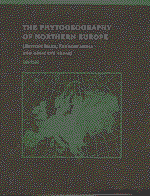Book contents
- Frontmatter
- Contents
- Preface
- Acknowledgements
- 1 Introduction
- 2 Climate
- 3 Edaphic factors
- 4 The geological history of the present European flora
- 5 The atlantic and oceanic elements
- 6 The thermophilic element
- 7 The boreal element
- 8 The arctic, alpine and montane elements
- 9 Endemic, disjunct and centric distribution patterns
- 10 Anthropochorous plants
- Appendix I Calculation of climatic parameters for comparison with plant distributional data
- Appendix II The Northern European species of Flora Europaea with indications of their status and climatic correlations
- Appendix III Arctic species of vascular plants
- Appendix IV Endemic species of vascular plants, bryophytes and lichens
- Appendix V Extra-European disjunctions – bryophytes and lichens
- References
- Index
5 - The atlantic and oceanic elements
Published online by Cambridge University Press: 23 October 2009
- Frontmatter
- Contents
- Preface
- Acknowledgements
- 1 Introduction
- 2 Climate
- 3 Edaphic factors
- 4 The geological history of the present European flora
- 5 The atlantic and oceanic elements
- 6 The thermophilic element
- 7 The boreal element
- 8 The arctic, alpine and montane elements
- 9 Endemic, disjunct and centric distribution patterns
- 10 Anthropochorous plants
- Appendix I Calculation of climatic parameters for comparison with plant distributional data
- Appendix II The Northern European species of Flora Europaea with indications of their status and climatic correlations
- Appendix III Arctic species of vascular plants
- Appendix IV Endemic species of vascular plants, bryophytes and lichens
- Appendix V Extra-European disjunctions – bryophytes and lichens
- References
- Index
Summary
The atlantic and oceanic elements consist of species with a southern and western distribution in Europe. The definitions of these elements have been thoroughly discussed by, for example, Troll (1925), Holmboe (1925), Kotilainen (1933), Degelius (1935), Fægri (1960), Ratcliffe (1968) and StØrmer (1969).
In dealing with the atlantic and oceanic elements it is important to distinguish between stenohydric and poikilohydric plants. Almost all vascular plants are stenohydric; if their cells dry out they die. Lichens and bryophytes are poikilohydric, as their cells quite normally dry out without causing serious damage. The ecology and distribution patterns of stenohydric and poikilohydric plants are quite different and to emphasise these differences, I will use the term atlantic for stenohydric plants and oceanic for the poikilohydric plants.
The atlantic element
Climatic correlations
An isotherm map of the temperature in the coldest month, calculated for the lowest point in each square grid in Atlas Florae Europaeae,is given in Fig. 11. The distribution patterns of atlantic plants are correlated with these isotherms.
Within the atlantic element a number of sub-elements and groups can be recognised according to the correlations between the distribution limits of the species and the winter temperature isotherms. The following sub-elements can be recognised (see Appendix II which lists all the correlations).
The British–Mediterranean sub-element
This consists of species limited in Britain and Ireland to areas with winter temperatures higher than +6C. Isoetes histrix (Fig. 12) is an example.
- Type
- Chapter
- Information
- The Phytogeography of Northern EuropeBritish Isles, Fennoscandia, and Adjacent Areas, pp. 40 - 54Publisher: Cambridge University PressPrint publication year: 1998



